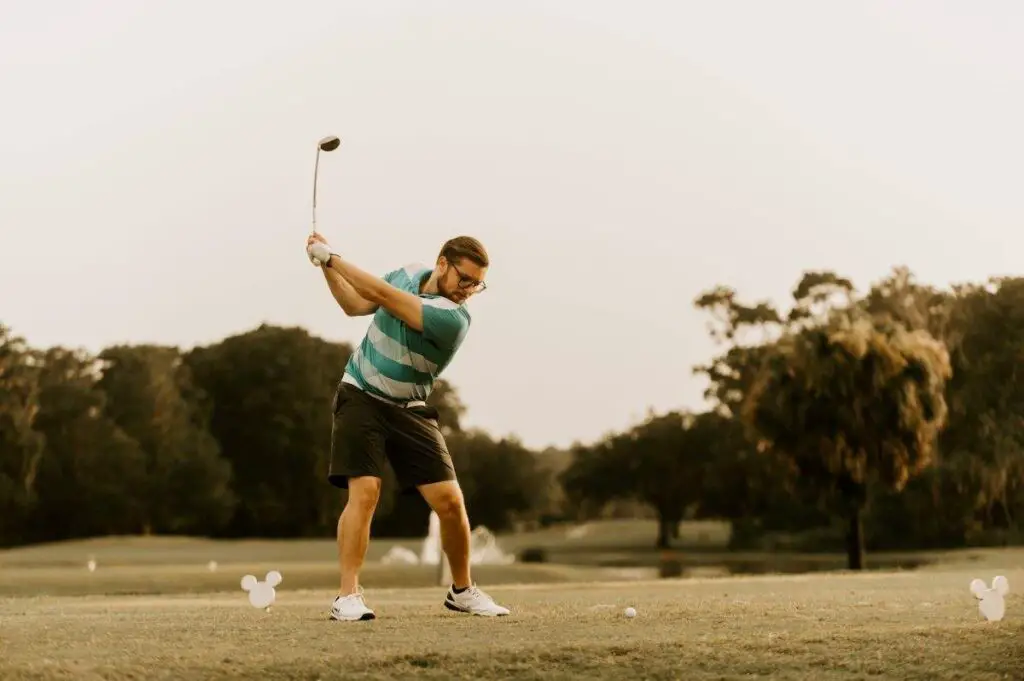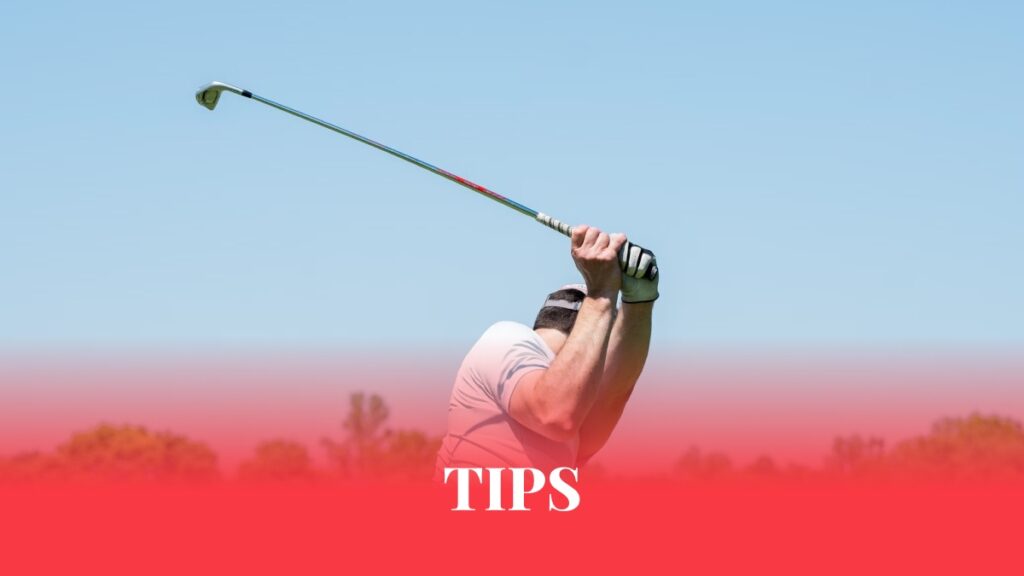In this Article
Learn proper bowed wrist golf swing technique, from address adjustments through impact mechanics. Get the facts on this position's benefits for power and consistency, while debunking common myths. Tips to implement bowed wrist mechanics tailored for your swing and body.
A bowed wrist is a crucial yet often misunderstood part of the golf swing. With a proper bowed wrist position, golfers can gain more consistency, power, and control over their shots. However, myths abound regarding technique, effectiveness, and potential downsides of using a bowed wrist. This article will define what a bowed wrist golf swing is, dispel common myths, present key facts supported by experts, and provide helpful tips to improve this important element of any strong golf game.
The bowed wrist refers to a position where the back of the lead wrist angles slightly toward the body at address. This angle is maintained during the backswing, increased slightly at the top, and retains a slight bow through impact with the ball. The amount of bow ideal for each golfer depends on factors like arm length, flexibility, swing mechanics and preferred shot shape.
Maintaining a bowed wrist enables the lead arm and club to work together as a unit. This builds power while minimizing wayward shots. A proper bowed wrist promotes squarer clubface contact for consistently solid ball-striking. At the same time, it allows the wrists to hinge and unhinge naturally, contributing to an efficient, rhythmic motion.
While a bowed wrist position is advantageous for many players, it must be executed correctly to reap benefits and avoid injury. Some golfers are better suited to a flat or cupped wrist, depending on their swing path and body mechanics. By examining common myths alongside evidence-based facts, golfers can determine whether a bowed wrist could improve their game. With personalized practice and drills, a bowed wrist can then be added to their repertoire for more repeatable, accurate swings.
Table of Contents
What is a Bowed Wrist Golf Swing?

A bowed wrist refers to a specific position and motion of the lead wrist during the golf swing. When executed properly, it can provide multiple benefits for ball striking, power, and consistency.
Proper Wrist Angles
At address, the lead wrist should have a slight angle toward the body rather than being flat on the club. This is the “bowed” position. The trailing wrist may be flat or slightly angled away from the body. Together, these wrist positions allow for a full range of hinge and release motions during the swing.
The exact degree of bowing at address depends on the golfer’s arm length, flexibility, and stance width. A good starting point is 5-15 degrees of bow at setup. From there, golfers can tweak based on feel and observation of ball flights.
Maintaining the Bow
During the backswing, the lead wrist should maintain its initial bowed angle. As the wrists hinge, the angle may increase slightly but should not become overly exaggerated.
At the top of the backswing, many players have a bowed wrist position of 30-45 degrees. However, others have success with less bowing. Finding the right depth of hinge for your swing is key.
As the downswing begins, the lead wrist bow angle should be maintained as the club drops into the slot. Just before impact, the lead wrist bow is reduced to around 10-20 degrees.
Impact and Release
During the release, the lead wrist transitions from bowed to flat or slightly cupped at impact. This allows the clubface to square up for solid contact.
The trailing wrist also unhinges from its cocked position, adding closing power to the clubhead. After impact, both wrists continue to release fully through the ball and into the follow-through.
Common Traits
When executed correctly, the bowed wrist position shares common traits among golfers:
- Consistent lead wrist angle and hinge depth from swing to swing
- Efficient wrist-cock and unhinging motion
- Squared clubface through impact due to proper release
- Powerful strikes and increased clubhead speed
- High, right-to-left ball flights
- Ability to control shot shapes when required
Mastering this wrist action requires practice and self-analysis. But with proper technique, a bowed wrist can provide a solid foundation for an effective, repeating golf swing.
Myths About the Bowed Wrist Golf Swing

Several common misconceptions surround the bowed wrist golf swing. By examining these myths versus the facts, golfers can make informed decisions about using this technique.
A Bowed Wrist Always Causes a Hook
One myth is that a bowed lead wrist inherently causes hooked shots. In reality, a bowed wrist does not have to produce a hook. If executed correctly, it can provide neutral or even faded ball flights.
The key factors are proper wrist angles during the swing, avoidance of over-bowing, effective clubface control, and appropriate swing path. With good mechanics, a bowed wrist swing can launch the ball straight or with a slight draw.
You Must Bow the Wrist at the Top
Another myth proposes that maximum bowing should occur at the very top of the backswing. But this can over-hinge the wrist and lead to injury over time.
What matters most is assuming the proper wrist angle at address and maintaining close to that position during the backswing. Allowing some increased hinging toward the top is fine. However, forcing an exaggerated bowed angle can cause problems.
Bowed Wrist Increases Injury Risk
Some argue that a bowed wrist adds strain to the area, increasing the risk of injury. When executed poorly, a bowed wrist can strain the tendons and lead to issues over time.
However, a proper bowed wrist swing relies on efficient biomechanics. With practiced technique and appropriate flexibility, this wrist position can be maintained safely. Still, any new element added to the swing should be monitored closely.
Bowed Wrist Limits Power
Contrary to popular belief, a bowed lead wrist can increase clubhead speed and power. The wrist hinge and release motion contribute substantial force when coordinated properly.
In fact, many top professional players utilize a bowed wrist for its power-boosting effects. The key is learning correct technique through personalized instruction and feedback.
Proper wrist angles, motion, and release are crucial for unlocking the power potential in a bowed wrist swing. When executed correctly, this technique generates impressive club speeds.
Bowed Wrist Fixes a Slice
Some golfers believe adopting a bowed wrist itself will banish their slice. In reality, multiple swing adjustments are usually required to fix that ball-flight pattern.
While a bowed wrist can reduce an open clubface, other factors like swing path, grip, alignment, and shoulder rotation may be causing the slice. Bowing the wrist alone is unlikely to provide a total solution.
Bowed Wrist Only Works for Certain Swings
Lastly, some argue that a bowed wrist only benefits certain swing types or body types. However many golfers of various sizes and with different mechanics can take advantage of this technique.
Proper instruction, feedback, and customization enable most players to achieve an effective bowed wrist swing. With practice, nearly any golfer can find their own optimal bowed wrist mechanics.
The key is not believing common myths. Instead, rely on facts, personalized testing, and input from experts. This approach will reveal whether a bowed lead wrist could offer an advantage.
Facts About the Bowed Wrist Golf Swing

Unlike some pervasive myths, several evidence-based facts highlight the potential benefits of using a bowed wrist in the golf swing.
Promotes Consistency
One proven advantage of the bowed wrist is increased consistency in ball-striking and shot patterns. The fixed wrist angle provides a stable base to swing from and return to. This minimizes variability in delivery and contact.
Studies reveal that golfers with a properly bowed lead wrist have tighter shot dispersions. Their clubface also returns to square more often, facilitating straight and predictable trajectories.
Wrist Bow Degree Depends on Individual
While some bowing is ideal for most, the exact angle degree differs between golfers. The proper bowing depth depends on factors like swing mechanics, flexibility, grip style, and anatomy.
For example, a golfer with limited wrist mobility may utilize a more mild bowing angle. In contrast, a flexible player with an upright swing plane may bow more deeply. Finding each individual’s optimal bowed wrist swing takes experimentation.
Not Riskier When Using Proper Form
When executed with proper technique, the bowed wrist position does not increase injury risk compared to a flat wrist. The key is maintaining efficient biomechanics without over-hinging or strain.
The same risks associated with poor swing mechanics apply whether using a bowed, flat, or cupped wrist. With reasonable wrist angles and caution, the bowed wrist swing can remain comfortable and controlled.
Generates Substantial Power
Contrary to myth, a bowed wrist can boost clubhead speed and power. This results from the stored energy built through effective hinging and unhinging of the wrists during the swing sequence.
The wrist cocking motion recruits major muscle groups. When coordinated correctly, this kinetic sequence culminates in forceful releases and faster swing speeds.
Promotes Squared Impact
At impact, a proper bowed wrist position promotes a square clubface strike. This results from the wrist unhinging and flattening motion just before contact.
With precise timing, the bowed wrist swing induces the clubface to return to neutral as it strikes the ball. This maximizes energy transfer for solid impact and accurate shots.
Added Trajectory Control
A bowed lead wrist gives golfers more control over launch angles and trajectory. This influence over height and curve allows for preferred ball flight patterns.
For example, a lower trajectory promoted by a flatter wrist may suit links-style courses. Meanwhile, the added loft of a bowed wrist can hold greens better on an approach. Adapting the bow angle facilitates shot customization.
When executed appropriately for the individual, a bowed wrist swing provides measurable performance benefits for all skill levels. Dispelling myths and focusing on sound biomechanics allows golfers to utilize this technique productively.
Tips for Improving Your Bowed Wrist Golf Swing

Implementing a proper bowed wrist golf swing requires patience and practice. Here are some tips to help golfers gradually improve their technique:
Evaluate Your Grip
An improper grip can undermine bowed wrist mechanics. Ensure your lead hand grip promotes a natural wrist hinge. Consult a pro if unsure about optimal hand positioning.
Maintain Wrist-Cock
Once set at address, consciously keep the lead wrist angled throughout the backswing. Avoid letting the wrist go flat or overly cupped before initiating the downswing.
Smooth Transition to Downswing
Work on a smooth hand path and rhythm as the club transitions from backswing to downswing. Avoid any abrupt motions that could negatively impact wrist angles.
Rehearse Release Moves
Incorporate practice drills isolating the release move through impact. Exaggerate the unhinging feel with half-swings and impact bags to ingrain that motion.
Strengthen Wrists and Forearms
Do targeted exercises with light weights, resistance bands, or a wrist roller to build strength in the bowed wrist position. This prevents any tendency to lose the angle.
Use Training Aids
Devices like wrist braces and weighted clubs provide biofeedback during practice. These tools reinforce maintaining the proper bowed wrist angle throughout the swing.
Monitor with Video and Data
Set up a video of your swing plane and clubface. Also, check wrist angles and club data on a launch monitor. Review this information to understand the effectiveness of your bowed wrist mechanics.
Start with Partial Swings
Begin practicing with half-swings, chipping motions, and partial wedge shots. Ingraining the correct motion is easier with less club speed before moving to full swings.
Keep Wrists Quiet Putting
While a bowed wrist can help full swings, keep wrists passive during putting. This allows a pendulum-like rocking stroke on the greens.
Watch for Overuse Issues
Ease into practice to avoid overtaxing wrists and forearms. Monitor for any pain signaling an overuse injury. Consider lessons to ensure you aren’t straining the bowed wrist position.
With attentive, progressive practice using these tips, most golfers can learn to perform an efficient bowed wrist golf swing. As with any skill, be patient with yourself through the improvement process.
Putting It All Together
A bowed wrist golf swing can be a beneficial technique when executed properly. However, it is not a magic fix for all players and must be implemented thoughtfully. By understanding key concepts and personalizing the motion, golfers may gain an edge from a bowed wrist position.
First, know that a bowed wrist itself does not universally improve golf swings. The ideal amount of bowing, if any, depends on the individual’s anatomy, flexibility, mechanics, and preferences. Some players may perform best with a more flat or cupped wrist. The key is finding what positions allow fluid hinging and release for your body.
Second, a bowed wrist should integrate smoothly within the total swing, and not disrupt a naturally effective motion. Work carefully to blend the wrist-bowing action with other pieces like stance, grip, rotation, and arm movement. Lessons can help tailor and ingrain this technique into a cohesive whole.
Finally, excellence requires commitment, feedback, and perseverance. Learn proper mechanics before expecting results. Use half-swings and isolation drills to ingrain the motion without introducing bad habits. Be open to continual refinement and customization for your swing. A bowed wrist can elevate ball striking when personalized and practiced intentionally over time. But no single adjustment guarantees improvement on its own.
In closing, keep an open mind about equipment, instruction, and practice methods that could work for your swing. Understand the facts about technique, but realize results come through a diligent process. Keep refining your motion as you enjoy the lifelong challenge and rewards of this great game.

